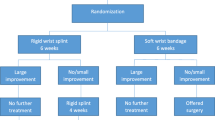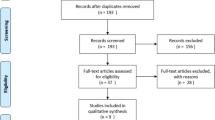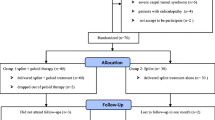Abstract
This study was undertaken to compare the clinical effectiveness and costs of postoperative splintage and late rehabilitation with a bulky bandage dressing versus early rehabilitation after carpal tunnel release. In this comparative study, 46 patients were randomly divided into 2 groups. In each group, 3 patients were excluded because of improper follow-up, leaving a total of 40 patients. Group 1 used a splint (exercises given 3 wk postoperatively) and group 2 was given a bulky bandage (exercises provided immediately) after open release. Patients were assessed preoperatively and at the first and third postoperative months with the Questionnaire of Levine for Clinical Assessment of Carpal Tunnel Syndrome. The 2 groups were similar in terms of preoperative functional status scores and in controls at the first and third months (P=.549,P=.326,P=.190). When both groups were compared, no statistical significance was found regarding symptom severity scale scores preoperatively and at the first postoperative month (P=.632 vsP=.353). At the third month, scores were lower in favor of group 2 (P=.023). Additionally, 16 of 20 patients (80%) in group 1 reported a heavy feeling and discomfort caused by the splint. This problem was not reported by the patients in group 2. The cheapest splint on the market was 9 times more expensive than a bulky dressing. The investigators concluded that postoperative immobilization with a splint has no detectable benefits. Use of bulky dressings and abandonment of the use of postoperative splints may prevent unnecessary expenditures without sacrificing patient comfort or compromising the course of healing in carpal tunnel surgery.
Similar content being viewed by others
References
Jessurun W, Hillen B, Huffstadt AJ. Carpal tunnel release: postoperative care.Handchir Mikrochir Plast Chir. 1988; 20: 39–40.
Bhatia R, Field J, Grote J, Huma H. Does splintage help pain after carpal tunnel release?J Hand Surg [Br]. 2000; 25: 150.
Finsen V, Andersen K, Russwurm H. No advantage from splinting the wrist after open carpal tunnel release: a randomized study of 82 wrists.Acta Orthop Scand. 1999; 70: 288–292.
Levine DW, Simmons BP, Koris MJ, et al. A self-administered questionnaire for the assessment of severity of symptoms and functional status in carpal tunnel syndrome.J Bone Joint Surg Am. 1993; 75: 1585–1592.
Falkiner S, Myers S. When exactly can carpal tunnel syndrome be considered work related?ANZ J Surg. 2002; 72: 204–209.
Latinovic R, Gulliford MC, Hughes RA. Incidence of common compressive neuropathies in primary care.J Neurol Neurosurg Psychiatry. 2006; 77: 263–265.
Gerritsen AA, de Vet HC, Scholten RJ, Bertelsmann FW, de Krom MC, Bouter LM. Splinting vs surgery in the treatment of carpal tunnel syndrome: a randomized controlled trial.JAMA. 2002; 288: 1245–1251.
Verdugo RJ, Salinas RS, Castillo J, Cea JG. Surgical versus non-surgical treatment for carpal tunnel syndrome.Cochrane Database Syst Rev. 2003;(3):CD001552.
Ucan H, Yagci I, Yilmaz L, Yagmurlu F, Keskin D, Bodur H. Comparison of splinting, splinting plus local steroid injection and open carpal tunnel release outcomes in idiopathic carpal tunnel syndrome.Rheumatol Int. 2006; 27: 45–51.
Bury TF, Akelman E, Weiss AP. Prospective, randomized trial of splinting after carpal tunnel release.Ann Plast Surg. 1995; 35: 19–22.
Keilani MY, Crevenna R, Fialka-Moser V. Postoperative rehabilitation of patients with carpal tunnel syndrome.Wien Med Wochenschr. 2002; 152: 479–480.
Cook AC, Szabo RM, Birkholz SW, King EF. Early mobilization following carpal tunnel release: a prospective randomized study.J Hand Surg [Br]. 1995; 20: 228–230.
Author information
Authors and Affiliations
Corresponding author
Rights and permissions
About this article
Cite this article
Cebesoy, O., Kose, K.C., Kuru, I. et al. Use of a splint following open carpal tunnel release: A comparative study. Adv Therapy 24, 478–484 (2007). https://doi.org/10.1007/BF02848769
Issue Date:
DOI: https://doi.org/10.1007/BF02848769




